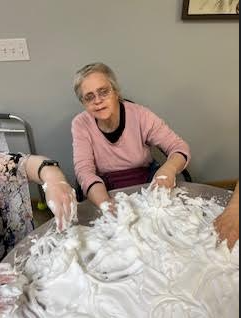Beyond the Trauma, what happens after a TBI?
- Dani Harris
- Oct 23, 2024
- 3 min read
Within the Neurodiagnostic field, we are accustomed to witnessing trauma either at the time of its happening or during medication follow-ups years later. The journey in between is not always visible to us.
I am fortunate enough to have a TBI facility in my community that helps me understand in real time what books and research can only touch on. When we think of long term care facilities, the image that comes to my mind is not very pretty. I tend to picture outdated beige and brown facilities that feel as depleted as the decor.
It was quite surprising for me to meet Darcie Hanson from HIT Inc./Dakota Pointe (https://www.hitinc.org/contact). Our acquaintance was made possible by mutual friends, and over the years, we have developed a strong friendship. While I was aware of Darcie's work with traumatic brain injury patients at her facility, it wasn't until last year that I delved deeper into her expertise through our discussions on TBI training. Upon realizing the extensive training her staff undergo, I was amazed by the close connection between our respective fields.
Hit Inc operates various facilities, and I have not visited all of them. I had the opportunity to visit Darcie's facility in Mandan, ND, which is funded by the government and subject to strict regulations. During my initial visit, I had the chance to meet the staff and discuss the alignment between my work and theirs. The facility exuded a warm, clean, and bright atmosphere, with residents and staff engaged in their daily activities. They greeted me warmly, making me feel like a part of their community.
Upon meeting the residents and staff and touring the facility, I observed the extensive rehabilitation efforts integrated into their well-organized daily routine. The residents exhibit varying degrees of Traumatic Brain Injury (TBI), some with complex conditions encompassing multiple comorbidities resulting from the initial trauma, while others have more straightforward limitations and recovery prospects. The unwavering dedication of the staff and their commitment to resident care and quality of life remain consistent. Unbeknownst to them, the staff plays a crucial role in the residents' rehabilitation process.
Residents engage in daily group sessions involving music therapy and various activities tailored to suit their individual abilities. Each resident takes part in daily living self-care tasks on a rotational basis, fostering learning opportunities for independent living. Additionally, every resident follows a personalized exercise program. While these activities may appear simple, they have led to remarkable growth and progress among residents with recovery limitations in this environment. This demonstrates the brain's capacity for continued repair and adaptation to establish a "new normal".
During my visit, I engaged in stimulating activities with the residents. We spread plastic sheets on the tables and covered them with shaving cream. I encouraged the residents to experience sensory stimulation and unleash their creativity by sculpting or drawing in the foam. Although this activity may appear trivial, it was truly rewarding to listen to the residents share their thoughts on the texture of the foam and articulate the sensations it evoked. Additionally, we hid enjoyable surprises in the foam, allowing everyone to eagerly search for hidden treasures.
Keep in mind that these individuals with traumatic brain injuries have significant and enduring impairments. However, this does not imply that they are incapable of leading fulfilling lives and making progress in everyday activities that we often overlook. Some patients were initially deemed unlikely to achieve a typical life, based on their recovery potential. Yet, through proper care and established routines, a few of them now hold jobs and lead lives that closely resemble our own, complete with daily schedules. Although they still require assistance to live autonomously, they manage to maintain motivation and determination to continue progressing.
How is this relevant to EEG? We are aware of the numerous mysteries surrounding the brain and its potential. In EEG, analyzing the initial injury diagnostic tests in comparison to the patient's progress over years of therapy can provide insights into the brain's healing process and lead to the development of additional therapies to improve quality of life by focusing on brain activity near the injury site.
Biofeedback is an EEG modality that utilizes these principles to enhance athletes' stamina, endurance, and even address certain medical conditions like seizures and Raynaud's Syndrome. These improvements can be observed through EEG tracings (recordings). Various types of Biofeedback therapies are available to assist patients under the supervision of a healthcare provider.
I can only wish for an increase in the number of facilities provided for patients and families. I am eager to return and engage in stimulating activities with my new friends.
TBI resources:
https://braintrauma.org/Beyond the Trauma, what happens after a TBI?







Comments